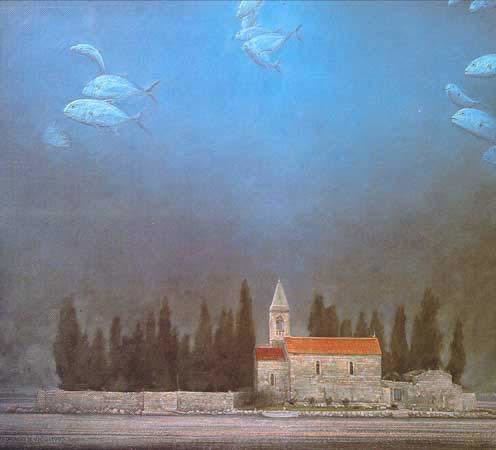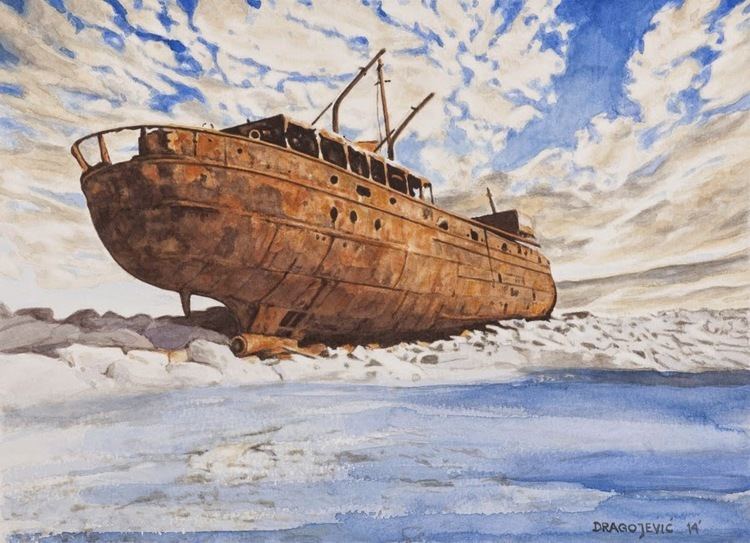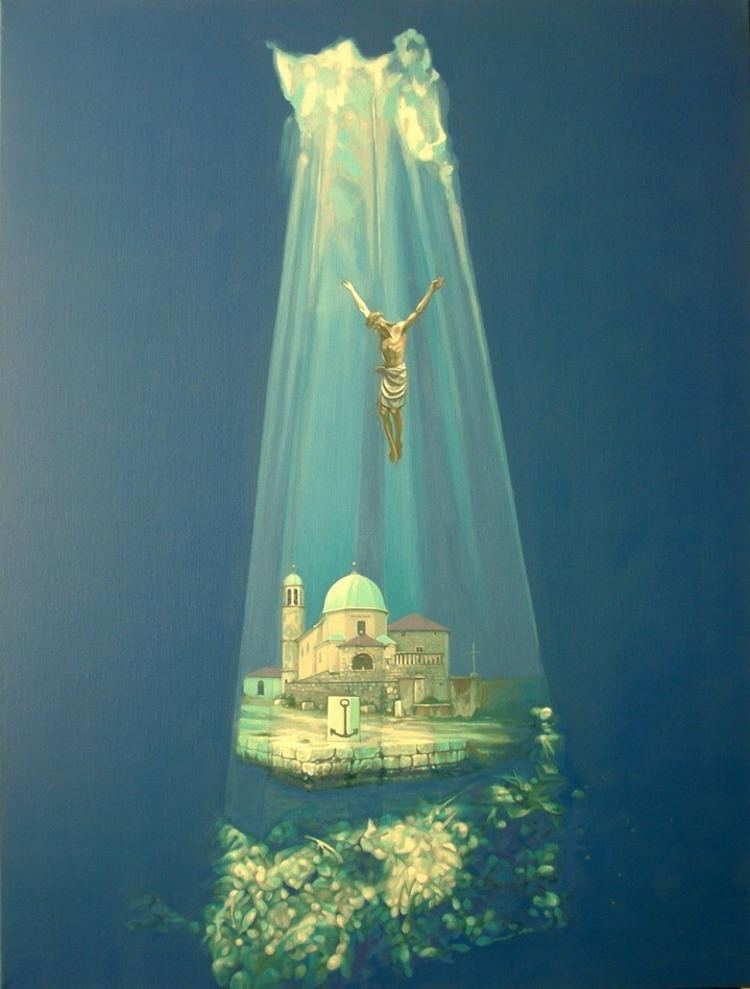Nationality [Montenegro] Name Boris Dragojevic | Role Artist Period Surrealism | |
 | ||
Full Name Boris Vojo Dragojevic Known for Painting, drawing, writing Movement Surrealism, hyperrealism Education Academy of Fine Arts, Belgrade | ||
BOJE JUTRA - Slikar Boris Dragojević
Boris Dragojević (Serbian Cyrilic: Борис Драгојевић) (born in Cetinje, Montenegro, Yugoslavia) graduated at the Faculty of Fine Arts in Belgrade. He studied painting in the class of Professor Mirjana Mihac and got his master's degree at the Department of Painting in 1986.
Contents
- BOJE JUTRA Slikar Boris Dragojevi
- Archeology of Light
- Seaside motifs
- Mediterranean
- Dilber
- Solo exhibitions
- Group exhibitions
- References

Dragojević has been a member of the ULUS (Association of Visual Arts of Serbia) and free-lance artist since 1984.
Archeology of Light

Dragojevic belongs to a family of Mediterranean painters, a small assembly of brothers by sea. Among them are also Marko Murat, Emanuel Vidović, Pedja Milosavljević, Zvonimir Mihanović; and the younger ones are Momčilo Macanović and Saša Montilio. They are all painters of Mediterranean airs, the Southern sun, whose paintings have a scent of pines, cypresses and other plants growing by the sea. Perhaps that is why everything in his works is sanctified and lit, touched by spirit and miraculous. As if fire-flies are in the sea, and Locrum, Korčula and Our Lady of the Rocks become warm nests above the abyss.

Everything is humanized on Dragojevic's paintings, even the civilization chaos. Bay of Kotor is the center of the world, crystal of the sea and skies, and its immense depths are the birthplace and geography of dreams. Ships sail through the skies and underneath children play with delicate, colorful pebbles. Flanks in a marina of a forgotten old ship, crashed and washed out by numerous waves, a world in which a church is placed. In keeping with the ancient saying "It is necessary to sail, it is not necessary to live", every human being is a sailor. The painter is a Robinson who, like a novice, repents and atones for sins. He uses his brush to chase away evil, and his work wakes the spirit from eternal sleepiness. The painter is in collusion with eternity and sings it sweet canzones.

At the same time, Dragojević belongs to another family of painters. His opal colors, paintings that seem as if they were painted by precious lapis lasuli, transparent ultramarine, Prussian blue, cobalt from the bottom of the sea, invoke some of the dreadful, heavy, twilight beauty described in poems written by William Blake, Goethe and Rimbaud, and paintings by John Martin and Milovan Vidak. Dragojevic painfully lives his paintings. However, his works are not only Mediterranean and visionary. He uses his painting tools to move perspectives, bird's view becomes frog's view and scenes from the bottom are heavenly, according to the alchemical motto: "That which is above is like that which is below". In a way, those are holly paintings, a reply of gift to the challenges of the times of postmodern and post-technological utopia. He revealed how a painter doesn't have to be an icon painter to create sacral pieces, to respond to challenges of history, to make peace between Western and Eastern tradition, church and everyday life. Our Savior is at the bottom of the sea, because God is everywhere. Christ was crucified to atone for the sins of all living creatures, to relieve the earth and heavens. Scenes of crucifixion symbolize resurrection and baptizing by light. There are the first waters and heavens from the beginning of Genesis.

This artist brought a seldom found union of sharpness and poetics. He joined hyperrealism with the intimacy of Belgrade school, the precise figuration with discrete imagination. He sailed the seas of melancholy, but he didn't sink. He walked the deserted docks and beaches where a sense of being thrown into the world wakes from the very depths of human beings, where winds of doubt roar, yet everything is peaceful and in harmony. Isle of the Dead by Arnold Böcklin, under the intoxicating Mediterranean sun becomes the island of life. In the name of Dragojević's empire, it is best to remember Schopenhauer's advice "Before wonderful paintings we should be silent and wait for them to address us first" or Paul Valéry's thoughts "When you write about art of painting, ask for its forgiveness".
Seaside motifs

Works of Boris Dragojević present him as an artist of hyperrealism, prone to shrewd surrealistic observation and obsessed with sea and underwater world, shores and monuments.
Dragojevic speculates, in a rather peculiar way, about life and its poetic text which follows his paintings in the catalogues. He claims: »Those propellers do not propel my submarine any more. There are too many wishes for the eyes of just one person". These words vibrate deeper on the sight of quite extraordenary paintings "The Blue Korcula" (1999). It is a canvas full of blue light. Under the rays of imperceptible sunset, Korcula is shining, with its protruding red roofs; in the richly coloured blueness, the fish are floundering, trying to emerge to the surface, along with a big yellow turf of seaweed; from the other side comes a shoal of pink fish; dazzling surreal but familiar and warm sight, skillfully and patiently elaborated. The same mixture of undersea world, in some sense unreal, and real sea motifs – is the characteristic of other painters too.
In "Band under the false pearls", over the group of singers the ensnared shells are glimmering, over "St George and Lady of Škrpjel", the tiny clouds are twinkling and at the bottom a shoal of fish; in the corner, there is some kind of submarine (a motif seen in every painting: the artist's symbol for penetrating into impenetrable) whose prepellers are moving silently.
According to Rajko Vujisic, »the perceptible and sensual world of Dragojevic, the world over and under the sea, as well as his colouristic plays and opservations recommend him as a homomediteraneus" among the painters; Dragojevic in the peculiar but expected way of his, finds the universal note and balance in the varieties of his central message.
That is all Dragojevic's aesthtics and symbolism, somewhat strange but pure, mysterious but not at all morbid.
Mediterranean
The central part of Dragojevic's artwork lies in his hereditary and post-hereditary experience combined with a brilliant creative ability. The first impression about his paintings is the exquisite technical knowledge. It is a very rare skill and leads to ultimate precision, the materialization and sensual quality of every single detail in his paintings. The seas, skies, stones, on-the-shore pulled out served barges. The artistic world of Boris Dragojevic lies in the mixture of real and surreal: he builds up some new visions of magic attraction. The recognizable motifs are taken from our very neighbourhood. The old buildings made of stone, Sveti Stefan, Perast, Our Lady of the Rocks (Gospa od Škrpjela), Sveti Đorđe Island, the temple of Bellavista...
Dragojevic enchants with his imagination, with painting by painting, turning upside down that real world, exchanging it for the world of fantasy. A newly cycle of his is but a new confirmation of his qualities and true Mediterranean sensibility.
Dilber
In early 1990s, thanks to his collaboration with a French publishing house Les Humanoïdes Associés, artist Boris Dragojevic launched into the world of comic book; the collaboration ended up after the outbreak of the war in 1991. For the first time in Belgrade, we saw extracts from the first unfinished series of an alternative comic book Lieutenant Dilber (sailor).
That avant garde comic book is imbued with humour and vision, conjuring up the legacy of pop-art and, in a rather satirical manner, predicting the future events in ex-Yugoslavia. Although it has never been published, this comic book remains a rare and most precious artistic achievement of the murky years of last decade.
Solo exhibitions
Waiting for the Ship Bound for Montenegro – Masters of Arts Exhibition, Gallery of FFA, Belgrade 1986.
Dedicated to Sergio Blazic – INA (Petrol Industry), Zagreb 1987.
Notturno 1 to 11 – Art Pavilion, Podgorica 1988.
Mediterranean Metal Magnoliaceae – Yugoslav Art Gallery, Belgrade 1994.
Between the Extremes – Ljetnjikovac Buca – Lukovic gallery, Tivat 1997.
Something in between – Sue Ryder Gallery, Herceg Novi 1997.
Mattins]] – Museum of Ruma 1998.
In memory of Gojko Berkuljan – Gallery Most, Podgorica 2001.
Those propellers... – Ljetnjikovac Buca – Lukovic gallery, Tivat 2001.
Each one carries own cross – Yugoslav Art Gallery, Belgrade 2002.
Brothers by sea Gallery Geca Kon, Belgrade 2004.
Abysses – Gallery Open University Subotica, Subotica 2004.
Mediterranean Story – Gallery Basement, Novi Sad 2005.
20 Years of devotion – Gallery Progres, Beograd 2005.
Group exhibitions
Contemporary Montenegrin Drawings (young) – Youth Centre, Podgorica 1983.
ULUS's New Members – Belgrade 1984.
Young Montenegrin Artists – Youth Centre, Podgorica 1984.
III Exhibition of Contemporary Montenegrin Drawings – Youth Centre, Podgorica 1985.
XIV Prospective – Yugoslav Art Gallery, Belgrade 1986
Colours of Boka – Vincent iz Kastva gallery, Istrian National Theater, Pula 2002.
